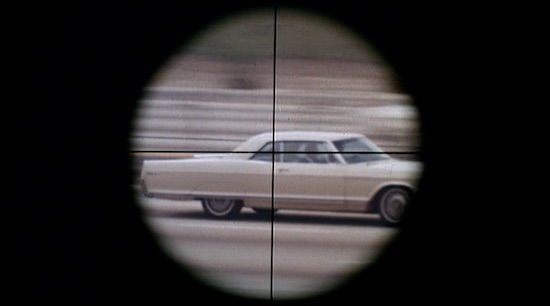Peter Bogdanovich’s debut feature, Targets, released in the US fifty years ago on 15th August, 1968, remains a trenchant comment on gun control in America. Current statistics show that the U.S. has the highest gun homicide of any developed country, and mass shootings by lone gunmen – like the sniper killings in Targets – continue on a regular basis. In the years following 1968, according to some commentators, there have been more gun-related deaths on American soil than in all the U.S. wars since the American Revolution (including World War Two and the war in Vietnam). The right to bear arms is enshrined in the Constitution, and American history and culture are inextricably bound up with guns; firearms thread through American identities, constituting and threatening them all at once.
Hollywood cinema has its part to play in all of this, of course. The gun is a staple of Hollywood; indeed, if it hadn’t already existed, Hollywood would have had to invent it. A truth that Jean-Luc Godard recognised when he claimed in 1964 (quoting DW Griffith): “all you need to make a movie is a girl and a gun”. One of the first ever close ups in cinema was of a man aiming a gun at the camera (in Edwin S. Porter’s The Great Train Robbery, made in 1903). Guns are used by Hollywood as a short cut to drama. “When in doubt, have a man come through the door with a gun in his hand”, Raymond Chandler once advised authors of crime thrillers. In movies, guns are seen as an easy solution – if someone becomes a problem, you shoot them.
In Targets, by contrast, guns are shown not as the solution but as the problem. The film’s sniper (played by Tim O’Kelly) isn’t a rebel. He’s not a beatnik or a hippy, or even a 50s-style juvenile delinquent, but a clean cut young man by the name of Bobby Thompson who lives with his wife and his parents in a clapboard house in the suburbs. He addresses his father as “sir”. He says his prayers at mealtimes. One day, seemingly out of the blue, he types a confession stating that he is going to kill his family, and then we see him do just that. He shoots his wife and mother, and then positions himself on the roof of a tall building and starts to kill people at random, just like Charles Whitman did two years before Targets, and just like the Las Vegas shooter did almost fifty years after Targets (with over one-and-a-half million American gun related deaths in between).
We never really know why Bobby in Targets kills all those people, just as we never really understood why Charles Whitman did what he did. What Bogdanovich does show us, though, is how easy it is for Bobby to get the means by which to commit the murders. He simply walks into a store on the Sunset Strip, buys a gun. The store owner even throws in the ammunition for free because Bobby has an honest face. Besides, Bobby’s Daddy has been into the store many times. Bogdanovich exposes the ridiculous ease with which guns can be bought in America.
In Hollywood action movies people become targets on a shooting range. In a similar way, Bobby, as the title of the film suggests, comes to see people merely as targets to be shot at. We see him bonding with his father during target practice. They shoot tin cans together. When Daddy goes to line them up again, Bobby has him momentarily in his sights. We see his finger start to squeeze the trigger. “What are you doing?” his father berates him. “Never a point a gun at anyone!”
Something has dehumanised Bobby, or maybe he was just born that way. Possibly his experience in Vietnam brought about his psychosis, or maybe it’s the drabness and stultifying conformity of his life, or his inability to communicate with his family. Or perhaps he has become desensitised to the violence on his parents’ television, which is perpetually on, and to violence in real life. On the roof, as he emotionlessly picks off passing motorists, we see his victims in the cross-hairs of his scope, flat as images on a cinema screen. Certainly, the killer in Targets can no longer distinguish reality from fantasy, and Bogdanovich hints that movies may have their role to play in this, too. This may be why Bobby ends up gunning down the filmgoers at his local drive-in, where he encounters Byron Orlok (Boris Karloff) in the flesh, whilst Orlock’s image projects onto the movie screen at the very same time. Reality and fantasy merge into one. Bobby is finally brought down not by a police marksman, but by a slap around the face, and his gun taken away from him. Thus, Bogdanovich’s solution to America’s problem of gun control, in the film at least, is both simple and direct.
Targets is available on demand


